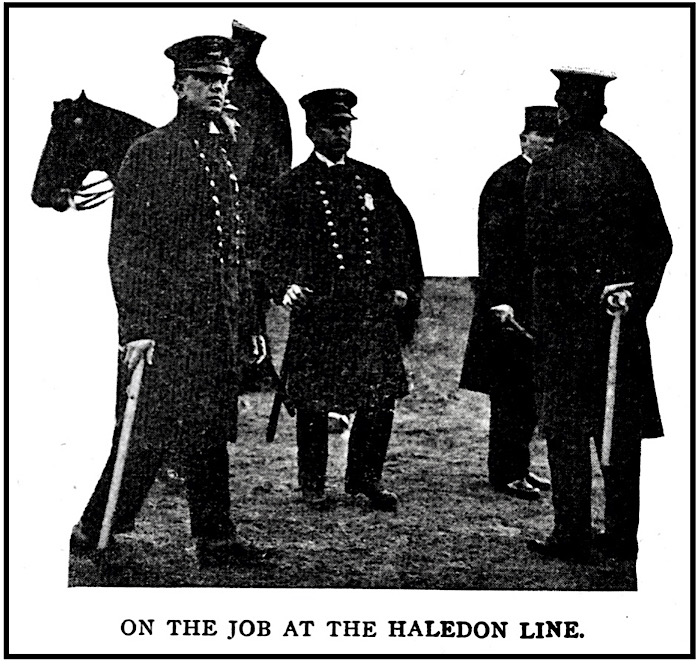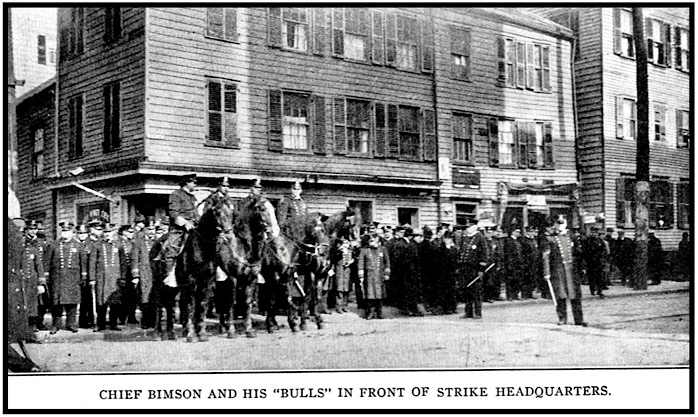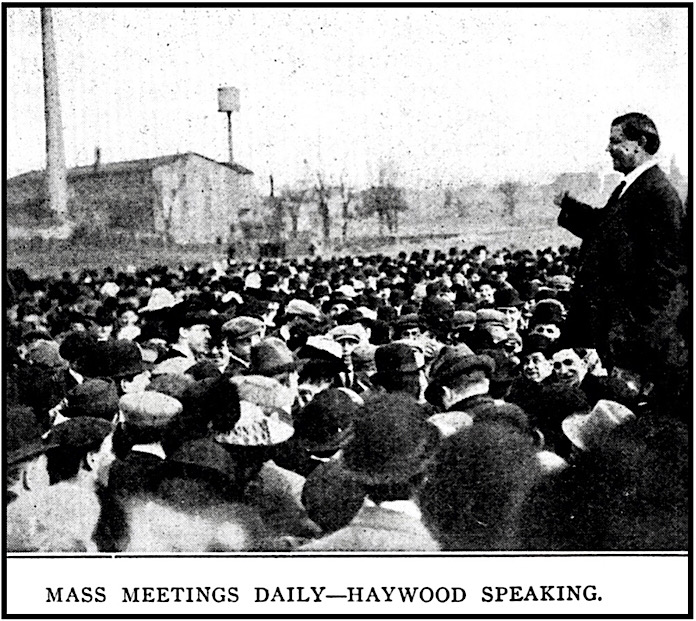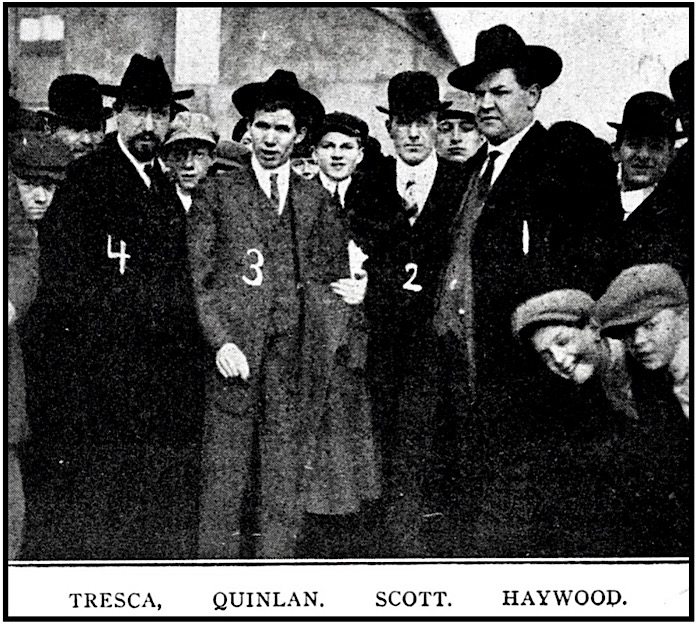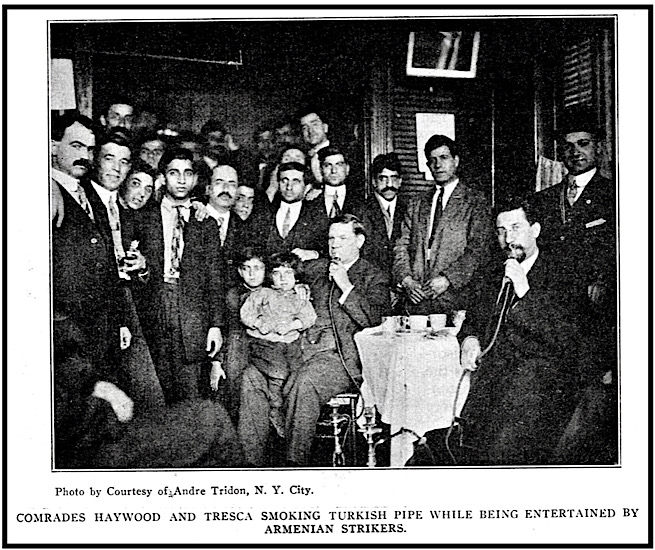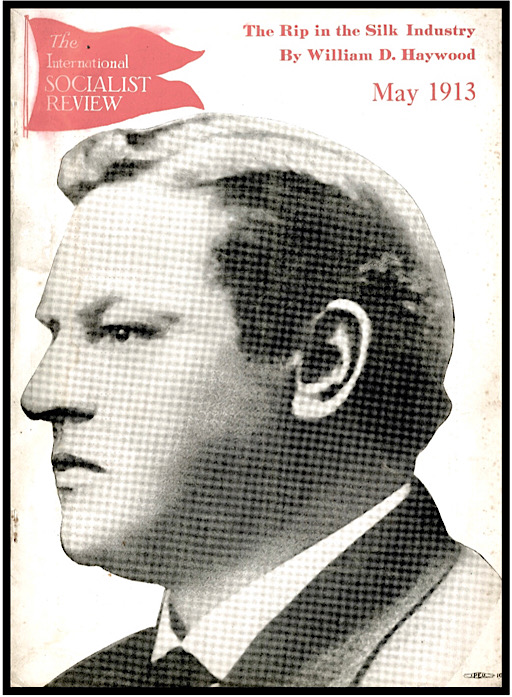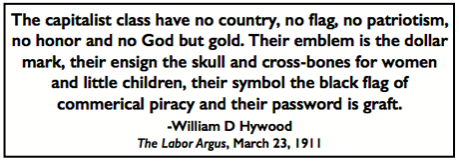 —————
—————
Hellraisers Journal – Sunday May 4, 1913
Paterson, New Jersey – The Arrest of Bill Haywood and Adolf Lessig
From the International Socialist Review of May 1913:
The Arrest of Haywood and Lessig
By Phillips Russell
DETERMINED that the 25,000 silk strikers of Paterson, N. J., should not listen to William D. Haywood on Sunday, March 30, the guardians of Paterson’s law and order, seized Haywood and Adolph Lessig on their way to Haledon and, in the interests of the mill owners, secured Haywood’s conviction and sentence to six months at hard labor, and Lessig to six months.
No single act or process in the proceeding had the least semblance of legality, and no attempt to make even a show of legality was made. The mill owners are represented on Paterson’s Police Commission by one of themselves. They appointed as Recorder one James F. Carroll, notorious in the city as a bar room politician. They wanted Haywood and Lessig out of the way; they had them seized by their police; they put them behind the prison bars, and intended them to stay there.
A mass meeting had been called for Sunday, March 30, in Lafayette Oval, which had been secured for the purpose by the strikers. On the preceding Saturday Police Chief Bimson issued an order prohibiting the meeting, but partly because of the lateness of the order’s appearance, but more largely because they believed they had the rights of free assemblage and free speech, the strikers ignored the order, and at the appointed hour began to pour in thousands down the roads leading to the meeting place.
In the meantime, a squad of special police detailed for special duty, namely, to prevent the meeting and disperse the crowd, held up Haywood and Lessig a block before they reached the Oval. The police informed Haywood that no meeting would be allowed, and that if he attempted to speak he would be arrested, whereupon the strikers within hearing distance shouted “On to Haledon!”
The cry was taken up by the thousands assembled, Haywood assenting: “All right we’ll go to Haledon,” and he began to walk the two miles beyond which lies the little Socialist municipality, followed by the strikers who had just learned that in Paterson they had no rights.
The crowd was perfectly orderly, although without any formation, but when it had got within half a block of the city’s limits the patrol wagon thundered through the mass of men, women and children to where Haywood and Lessig were walking in front. Motorcycle police had noted the general direction of the crowd and had rushed for the wagon, which was hooted and jeered by the strikers as it dashed directly for Haywood and Lessig.
Police Sergeant Ryan jumped out of the wagon, pointed at Haywood, saying, “You’re under arrest!” and grabbed Lessig, at the same time shouting, “Get Tresca!” Carlo Tresca, however, had dropped behind. As the wagon dashed by on its way to Haywood, some friends seized Tresca and hurried him into the house of a friend from whence he smiled pleasantly at the police who came to seize him.
After Haywood and Lessig were under arrest, the police, in a frantic effort to drive back the crowd, met with one who refused to be hurried. This was Messari, who was arrested and later arraigned on the same charges as the two principal defendants, some of the police conveniently swearing he was with them, as the amended charge required three defendants to make it legal.
“Have you a warrant?” asked Haywood of the policemen who rode with him in the wagon.
“I have,” answered one of them.
The three men were then thrown into the city jail, where Haywood was subjected to every indignity and outrage that a man can be forced to suffer. Almost immediately after the gate of his cell was slammed shut the jailors encouraged visitors to peer in between the bars as though he were a wild beast. This rubber-necking continued until 10 o’clock at night, when Haywood was brought out of the cell and paraded before the platoon of policemen about to go on night duty.
“Look at this man,” said Police Captain O’Brien. “You may need to know liim again.”
The inspection over, Haywood was locked again in his cell, to be interviewed at 3 a. m. by the prosecutor of Bergen County and the county’s detectives.
Again at 5 a. m. he was pulled out of his cell for yet another inspection by Paterson police going on morning duty.
No formal charge had been preferred against him while he was thus treated as outrageously as though he had been convicted of some loathsome crime.
There was good reason for no charge having been made. A complaint had been filed by the police after the arrest, alleging unlawful assemblage, but between the arrest and the court proceedings in the morning following, it was discovered that on the charge of unlawful assemblage he could not be convicted by the recorder, who would have had to accept bail. This, however, was not what the mill owners wanted, and the charge of “obstructing and interfering” was added. This charge could be heard before Recorder Carroll, who at the hearing found Haywood guilty of such obstructing and interfering. He was thereupon adjudged guilty of disorderly conduct and sentenced to six months at hard labor. The sentence stands as proof of the personal hatred felt toward Haywood by the mill owners and the authorities, for the recorder had no jurisdiction to sentence anybody to six months at hard labor, the sentence itself being utterly illegal.
Lessig’s conviction followed, and he was sentenced to six months without hard labor, while Messari was discharged.
Haywood, who had been taken to the patrol wagon to be hurried to the county jail to begin his sentence, was brought back into the court room to face the charge of “unlawful assemblage.” The motion of his attorneys to have the case dismissed for the reason that no offense had been mentioned in the complaint, was promptly overruled by Recorder Carroll, and Haywood was held in the sum of $5,000 bail. The same sum was fixed for Lessig, and Messari was paroled in the charge of his attorneys, no bail being fixed in his case.
A writ of certiorari was at once sued out for the disorderly conduct charge, and a writ of habeas corpus for the unlawful assemblage charge. Both writs were granted and bail furnished on the disorderly charge, and so far as the six months sentence was concerned both prisoners were released. On the unlawful assemblage charge they refused to accept bail, demanding a hearing on the writ of habeas corpus for the purpose of establishing the rights of themselves and of the hundreds of strikers who had been arrested on similar complaints. The authorities depended for conviction upon a law of the vintage of the. seventeenth century, passed in the reign of Charles II. For a week Haywood and Lessig lay in jail, awaiting a hearing on the writ of habeas corpus, while the strikers in monster mass meetings vowed not to return to the mills until Haywood and Lessig were released.
On Saturday, April 5, the hearing on the writ came before Supreme Court Justice Minturn, who, after subjecting the state’s witnesses to many painful questions, upon motion of Attorney Hunziker ordered the release of the prisoners, declaring they had been illegally arrested.
In the “course of the hearing Prosecutor Dunn protested, in support of the charge, that a crowd was following Haywood.
“Would you arrest me” asked the justice, “if a crowd was following me? These people wanted to see Haywood, and he cannot be held responsible for that.”
“But there was a great deal of noise,” urged the prosecutor.
“Do you arrest the Salvation Army, which always makes a noise?” countered Justice Minturn.
“Well, the prisoner was not going in the direction of his home, pleaded the prosecutor.
“Would I be arrested for walking toward Haledon because I do not live in that direction?” demanded Minturn.
Police Sergeant Ryan on the stand testified that people came to the windows and on their porches, and this was on Sunday. Judge Minturn in reply remarked they might have done the same on St. Patrick’s Day!
So ended one of the most flagrant outrages upon the rights of the working class that American records contain. It was a great victory for Haywood and Lessig and for the 25,000 strikers in whose behalf they were arrested.
In addressing a mass meeting of upwards of 20,000 strikers next day in Haledon, Haywood said:
“When Recorder Carroll sentenced me to six months at hard labor, he meant to sentence Paterson silk workers to ten hours’ hard labor every day for the rest of their lives. He meant to sentence the weavers to the three and four loom system. He meant to sentence every worker to perpetual wage slavery.”
[Emphasis added.]
~~~~~~~~~~~~~~~~~~~~~~~~~
SOURCES & IMAGES
Quote BBH Corporation Soul, Oakland Tb p11, Mar 30, 1909
https://www.newspapers.com/image/72436098/
International Socialist Review
(Chicago, Illinois)
-May 1913
https://www.marxists.org/history/usa/pubs/isr/v13n11-may-1913-ISR-riaz-ocr.pdf
See also:
Annual Report of the Bureau of Statistics of Labor and Industries
of New Jersey, for the Year Ending October 1913
NJ Bureau of Statistics of Labor and Industries, 1914
(search: paterson silk strike 1913)
(search with last names from article above)
https://books.google.com/books?id=EDUaAQAAIAAJ
Tag: Paterson Silk Strike of 1913
https://weneverforget.org/tag/paterson-silk-strike-of-1913/
~~~~~~~~~~~~~~~~~~~~~~~~~

